Mount Tai (泰山, Taishan Mountain, Mount Taishan), also known as Daishan (岱山) or Daizong (岱宗), is located in central Shandong Province, China. Covering a total area of 25,000 hectares, its main peak, Jade Emperor Peak, rises approximately 1,545 meters above sea level. Renowned for its majestic and imposing presence, Mount Tai is celebrated as the foremost of the Five Great Mountains of China and is often referred to as “the first mountain under heaven.”
Mount Tai holds a profound place in the 5,000-year history of Chinese civilization, embodying the nation’s prosperity and survival. It is a spiritual home for the Chinese people, a symbol of oriental culture, and a manifestation of the philosophical concept of “harmony between man and nature.” The mountain carries a wealth of geographical, historical, and cultural significance. Throughout history, it has been revered by the common people and used by emperors for ceremonial purposes. From the time of Emperor Qin Shi Huang to the Qing dynasty, 13 emperors personally climbed Mount Tai to perform Fengshan sacrifices, while 24 emperors sent officials to conduct sacrificial ceremonies 72 times.
The mountain is home to 29 ancient architectural complexes, 128 ancient ruins, and over 2,000 stone inscriptions and cliff carvings. Among these, the temples, palaces, and Taoist and Buddhist monasteries scattered across Mount Tai highlight its religious importance. The Dai Temple is the largest and most complete ancient architectural complex on Mount Tai. Its main hall, the Hall of Heavenly Blessings, is considered one of China’s three great halls, alongside the Hall of Supreme Harmony in the Forbidden City and the Hall of Great Perfection in the Confucius Temple.
Table of Contents
- Basic Information
- Location and Transportation
- Map of Mount Tai
- Highlights of Mount Tai
- Six Tourist Areas in Mount Tai
- Lengends about Mount Tai
- Vlog about Mount Tai
- Climate in Mount Tai
- History of Mount Tai
Basic Information
| Estimated Length of Tour | 1 day |
| Ticket Price | Hongmen Wanxianlou Walking Entrance (红门万仙楼步行入口): 115 RMB Dongyudao Walking Entrance (东御道步行入口): 115 RMB Taohuayu Walking Entrance (桃花峪步行入口): 110 RMB Tianwaicun Bus Entrance (天外村乘车入口): 150 RMB Taohuayu Bus Entrance (桃花峪乘车入口): 150 RMB Dai Temple: 10 RMB |
| Cable Car | Middle Heavenly Gate – South Heavenly Gate One-Way: 100 RMB Round: 200 RMB Taohuayu – South Heavenly Gate One-Way: 100 RMB Round: 200 RMB |
| Opening Hours | 24 hours a day throughout the year |
| Telephone Number | 0086-0538-96008888 |
Note of the different entrances:
Hongmen (Red Gate): This entrance is accessible by walking only and allows travelers to reach Zhongtianmen (Middle Heavenly Gate) on foot. From there, further ascent can be done either on foot or via cable car to Nantianmen (South Heavenly Gate).
Tianwaicun (Taiwai Village): Accessible by bus, Tianwai Village provides cableway up to Zhongtianmen for a fee of 35 yuan (one way). From Zhongtianmen, visitors can proceed to Nantianmen on foot or via the cable car (100 yuan one way). The famous Eighteen Bends (Shibapan) are along this route.
Taohuayu (Peach Blossom Valley): Visitors can take a bus or walk to Taohuayuan and then transfer to the cable car to reach Nantianmen (South Heavenly Gate) for 100 yuan one way. Nantianmen is just a 20-minute walk from the summit and is accessible only by foot.
Hongmen and Tianwaicun are more popular choices among visitors. For those with good physical fitness, hiking from Hongmen all the way to the summit is an option. However, for those less accustomed to physical exertion, starting the ascent from Zhongtianmen is recommended.
Location and Transportation
Mount Tai Scenic Area is located in the central part of Shandong Province, under the jurisdiction of Tai’an City. It spans approximately 200 kilometers east to west and 50 kilometers north to south, covering a total area of 24,200 hectares. To reach Mount Tai:
By High-Speed Train: Travelers can first take a high-speed train to Tai’an City.
From Tai’an City to Mount Tai Entrances:
- Hongmen Entrance: Take bus routes 45, 3/K3 South Loop, 3/K3 West Loop, 49/K49 and get off at Hongmen Station.
- Tianwai Village Entrance: Take bus routes 19, K37, K39 Inner Loop, K39 Outer Loop, K3 and get off at Tianwai Village Station.
- Taohuayu (Peach Blossom Valley) Entrance: Take bus routes K16, K49 and get off at Taohuayu Station.
Map of Mount Tai

Highlights of Mount Tai
Lingyan Temple (灵岩寺)

Lingyan Temple, located on the northwest slope of Mount Tai in the Wanfu Township of Changqing District, Jinan City, is approximately 45 kilometers north of Jinan and 25 kilometers south of Tai’an. The temple, accessible via National Highway 104 and the Beijing-Fuzhou Expressway (which has an exit for Lingyan Temple), boasts a history of over 1,600 years, having been founded during the Eastern Jin Dynasty. It is renowned as one of the “Four Famous Buddhist Temples” in China, along with Guoqing Temple in Zhejiang, Qixia Temple in Nanjing, and Yuquan Temple in Hubei.
The temple complex is home to numerous historical and natural marvels. Among its most notable features is the towering Pizhi Pagoda, an architectural masterpiece that seems to pierce the sky. The temple also houses the famous Iron Kesa, shrouded in legend and mystery. Additionally, visitors can explore the Banruo Hall from the Sui and Tang Dynasties and marvel at the colorful clay sculptures of Arhats from the Song Dynasty. Natural wonders abound in the vicinity of the temple, adding to its allure. Ming Dynasty writer Wang Shizhen once remarked, “Lingyan is the most secluded and enchanting part of Mount Tai. A visit to Mount Tai is incomplete without experiencing Lingyan.”
Puzhao Temple (普照寺)
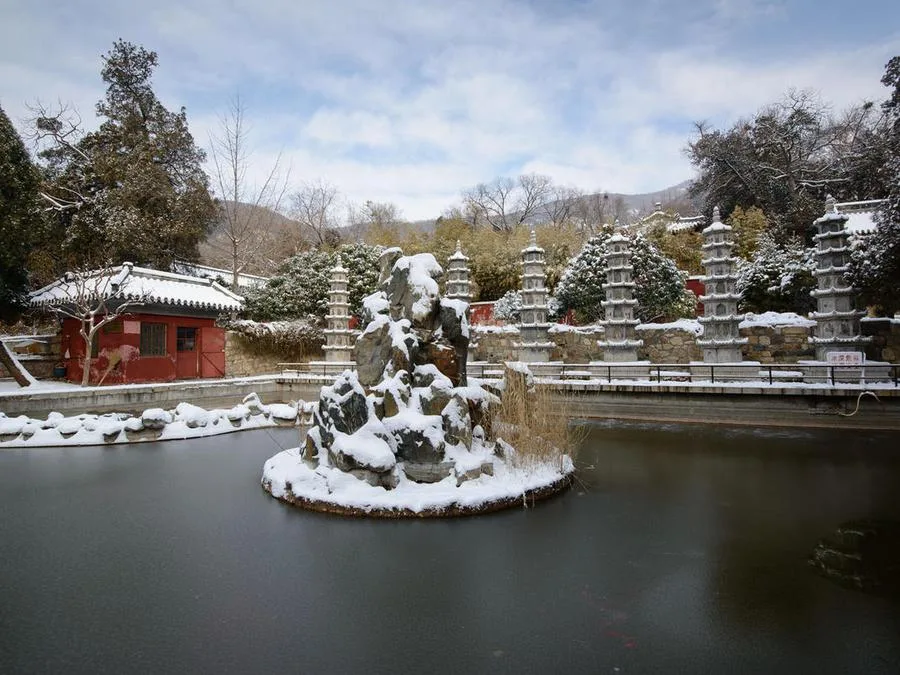
Puzhao Temple, located at the foot of Mount Tai’s Linghan Peak, covers an area of 6,150 square meters. The name “Puzhao” translates to “universal illumination of Buddha’s light,” reflecting its ancient heritage, believed to date back to the Six Dynasties period. Over the centuries, the temple has undergone numerous renovations and expansions. The temple’s layout features a central axis with the Mahavira Hall and Mosong Tower forming a three-tiered courtyard. Flanking these central structures are halls, meditation rooms, and gardens, creating a harmonious and tranquil environment.
One of the temple’s most unique features is the Six Dynasties Pine, a tree with branches spreading out like a grand canopy. Nearby is the Shaiyue Pavilion, named for the way moonlight filters through the pine needles, creating a shimmering effect like sifted silver. Inside the pavilion is a square stone table known as the Five-Tone Stone, which emits different sounds when struck, akin to musical chimes. North of the pavilion stands the Mosong Tower, which was a favorite retreat of General Feng Yuxiang during his stay at Mount Tai. Feng wrote numerous vernacular poems on local customs and the hardships of the people, later paired with Zhao Wangyun’s illustrations and engraved on stone steles within the courtyard. Though these original steles were destroyed, they have since been re-engraved.
Zhulin Temple (竹林寺)
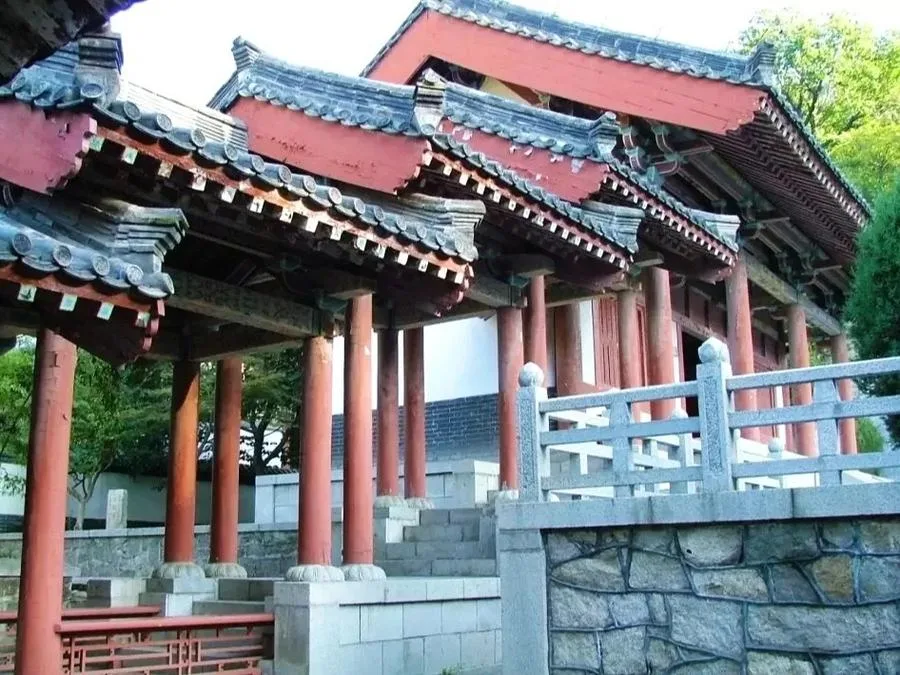
Zhulin Temple (Bamboo Temple), also known as Xuanyun Temple, was located in the Xixi Valley of Mount Tai, above Black Dragon Pool and northeast of the present-day Changshou Bridge. The temple was renowned for its picturesque scenery, with winding paths along the mountain, clear streams flanking the roads, and ever-changing views at every step. It was said to be an ancient temple of Mount Tai, with no exact record of its construction date, though it has been repeatedly restored and rebuilt since the Tang Dynasty.
Historical records indicate that the famous Yuan Dynasty monk Fahai undertook major repairs to Zhulin Temple during the Yuan Zhen period. In the Ming Dynasty, the Korean monk Mankong expanded the temple, bringing it to a period of prosperity. However, the temple was eventually destroyed in a fire. Today, it has been reconstructed on its original site in the style of the Tang Dynasty, preserving its historical and cultural significance.
Yuquan Temple (玉泉寺)
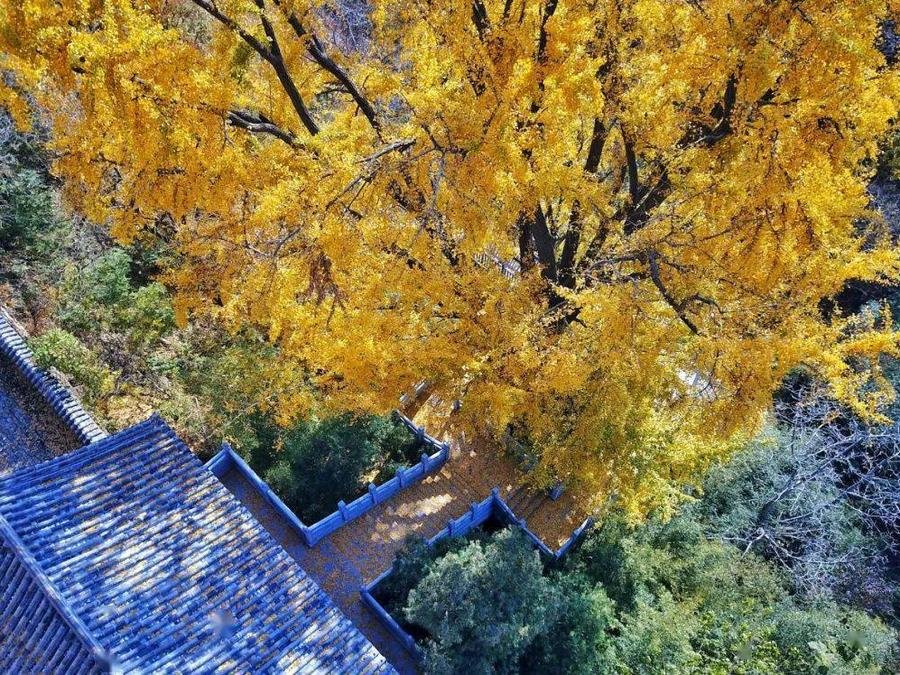
Yuquan Temple (Jade Spring Temple) is situated 6.3 kilometers north of the Jade Emperor Peak (Dai Peak), with a mountain path of over 20 kilometers connecting it to the main tourist routes. It is also accessible by road from Tai’an City. The temple is surrounded by notable landmarks: to the southeast lie Lotus Peak and Xianglu Peak, along with the historical site of Zhou Mingtang and Tianjing Bay; to the west is Motian Ridge; to the south is Maifan Pavilion; and to the north are Fandao Mountain and Changcheng Ridge.
Yuquan Temple was originally founded by the Northern Wei monk Yi, and later rebuilt by the Jin Dynasty monk Shanning. In the Yuan Dynasty, the monk Pujin added the Seven Buddhas Pavilion, but the temple experienced cycles of prosperity and decline over the centuries. It earned the names “Foyu” and “Fogu” due to the discovery of Arhat statues in the valleys by local mountain residents. The temple was also known as “Gushan Temple” and “Gushan Yuquan Temple” because of its proximity to Gushan Mountain to the south and the Jade Spring to the east.
The temple complex once included the Mahavira Hall, which housed a statue of Shakyamuni Buddha, flanked by the Eighteen Arhats, and surrounded by murals. In front of the main hall stood statues of Wei Zheng, a prominent Tang Dynasty politician. Unfortunately, the temple was destroyed during the Cultural Revolution. The ruins still contain ten stone steles and over twenty ancient chestnut trees that are over a thousand years old, offering a glimpse into the temple’s storied past.
Dai Temple (岱庙)
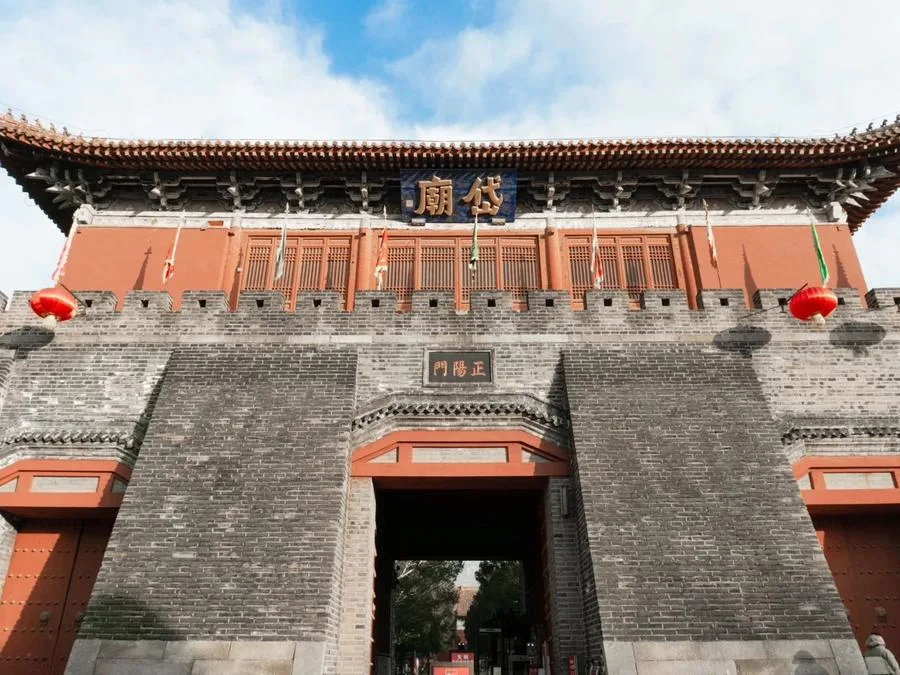
Dai Temple, a nationally protected historical site, is located at the northern edge of Tai’an City, at the southern foot of Mount Tai. Historically known as Dongyue Temple or the Tai’an Palace, it is the largest and most well-preserved ancient architectural complex on Mount Tai. Serving as a Taoist shrine, it has been the site for imperial ceremonies and sacrifices to the god of Mount Tai. Historical records mention constructions from the Qin and Han dynasties. The temple saw significant renovations during the Tang Dynasty (Kaiyuan period, 725 AD) and further expansions in the Song Dynasty (Dazhong Xiangfu period, 1009 AD). According to the “Stele of the Rebuilt Taiyue Temple,” it once housed 813 buildings. Some structures were destroyed during the Jin Dynasty, but repairs and additions continued through the Yuan Dynasty. The majority of the temple was burned down during the Ming Dynasty (Jiajing period, 1547 AD) and was rebuilt in the Qing Dynasty.
Designed in the style of an imperial palace, Dai Temple spans an area with a circumference of over 1500 meters and comprises more than 150 buildings. It is an architectural marvel, blending imperial grandeur with the natural beauty of Mount Tai.
Eighteen Bends (十八盘)
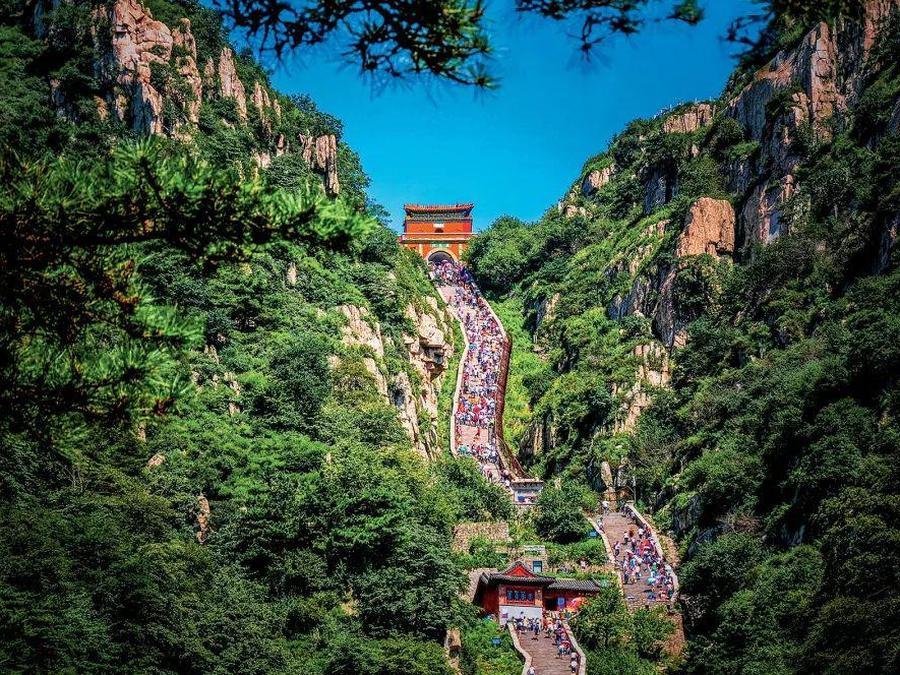
The Eighteen Bends is the most challenging section of the Mount Tai hiking path, consisting of 1,827 stone steps over an area of 8 square kilometers. This section is one of the key landmarks of Mount Tai. It begins at the North of Duisong Mountain, historically known as Yunmen (Cloud Gate), now referred to as Kaishan, which was renovated during the late Qing Dynasty. The path starts here and stretches towards Longmen (Dragon Gate), which once featured the Longmen Arch, now destroyed.
West of the cliff is a large “龙门 (Dragon Gate)” inscription in wild cursive script by Wei Xiang from the Daoguang period of the Qing Dynasty. Nearby is a narrow valley called Shibi Gorge, known for its “Thread of Sky” passage. Within this gorge, the path connects to Nantian Gate (South Heaven Gate) through Shengxian Arch. Nantian Gate, strategically positioned at the mouth of the valley, exemplifies the ancient Chinese architectural skill of integrating natural landscapes with human construction, marking an important symbol of Mount Tai.
The Eighteen Bends is divided into three sections: the “Slow Eighteen” from Kaishan to Longmen, the “Not Slow Nor Fast Eighteen” from Longmen to Shengxian Arch, and the “Fast Eighteen” from Shengxian Arch to Nantian Gate, totaling over 1,630 steps. The steepest part, “Fast Eighteen,” has an incline of 70 to 80 degrees and ascends 400 meters within less than a kilometer.
Bixia Temple (碧霞祠)
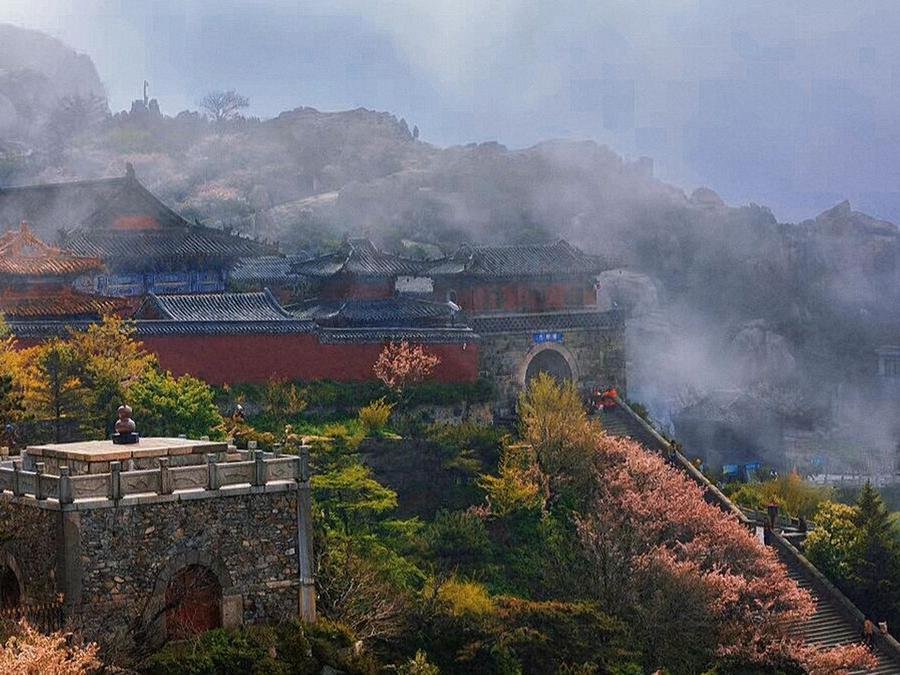
Bixia Temple, located at the summit of Mount Tai, is dedicated to the Goddess Bixia Yuanjun. Established in the first year of the Dazhong Xiangfu period of the Song Dynasty (1008 AD), the temple complex is divided into inner and outer courtyards by the main gate. In the inner courtyard, the main hall enshrines a bronze statue of Bixia Yuanjun, with its roof covered in bronze tiles, while the east and west halls are topped with iron tiles. The temple’s design and construction reflect the spiritual significance and reverence held for the goddess, who is believed to protect the local people and their fortunes. The intricate architecture and the serene atmosphere of Bixia Temple offer visitors a glimpse into the religious heritage and cultural devotion that have characterized Mount Tai for centuries.
Heavenly Street (天街)
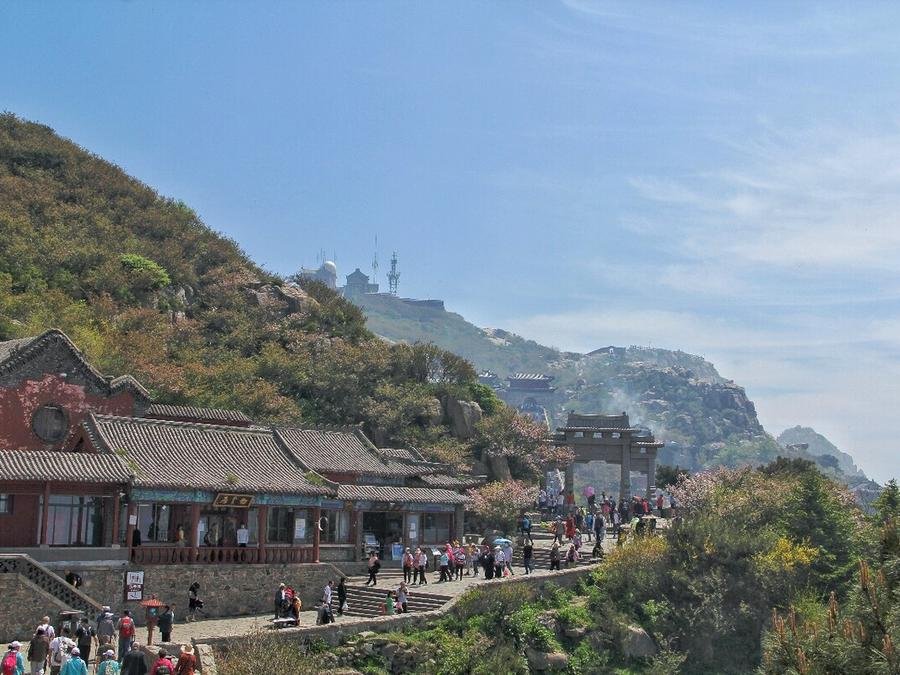
Tianjie, or Heavenly Street, is a unique and bustling thoroughfare stretching from the South Heaven Gate to Bixia Temple, spanning approximately 500 meters. This street, seemingly suspended in the heavens, has historically served as a vibrant marketplace. Along its nearly kilometer-long stretch, Tianjie is lined with hotels, restaurants, and shops. Records indicate that Tianjie began to flourish during the Qing Dynasty, with shopkeepers using tangible items like “wooden clubs,” “wooden bowls,” and “parrots” as their signs.
To the east of Tianjie Stone Archway stands the site of Emperor Qianlong’s palace and the former reading place of the Tang Dynasty literary figure Su Yuanming. The northern side of Tianjie features reconstructed ancient-style buildings, while the southern side boasts a long stone railing, offering visitors a panoramic view of Tai’an City’s nightscape. Tianjie is recognized as one of China’s top ten distinctive markets, offering a unique blend of history, culture, and commerce.
Sacrifice Cliff (舍身崖)
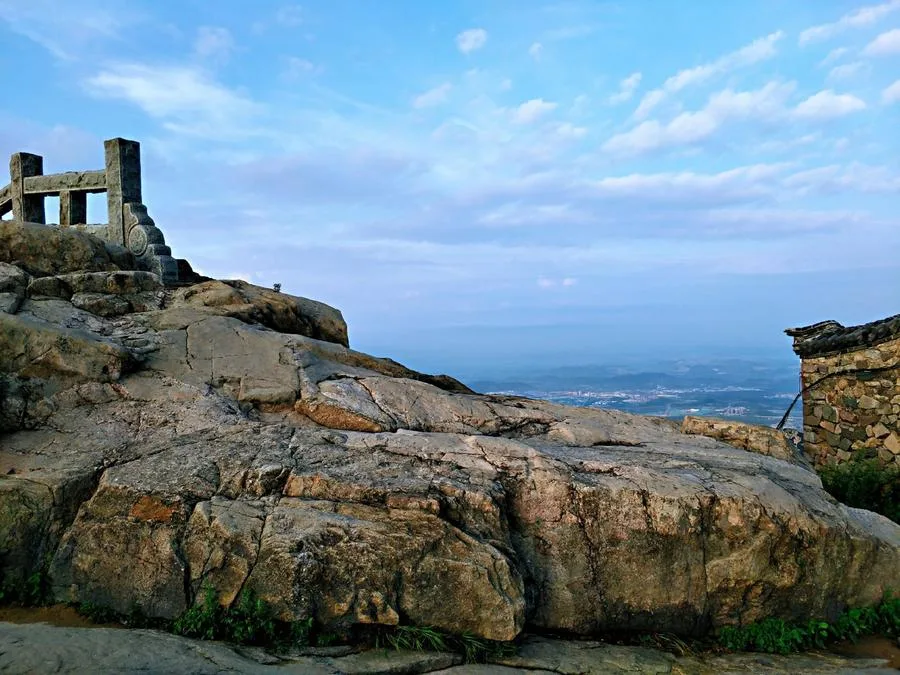
Sacrifice Cliff, located south of the Sunrise Peak, is also known as Aishen Cliff. The cliff is steep on three sides, with a deep abyss below. Historically, people seeking divine intervention for their parents’ illnesses would demonstrate their sincerity by leaping off the cliff. During the early years of the Ming Dynasty, Governor He Qiming constructed a wall beside the cliff to prevent these needless deaths and renamed it Aishen Cliff (Love Yourself Cliff) to promote the preservation of life. In the Kangxi period of the Qing Dynasty, Governor Zhang Qifeng repaired the wall and assigned guards to patrol the area.
In 1965, a round gate was opened at the southern end of the wall, and a stone railing was built along the edge of the cliff for viewing purposes. Atop the cliff stands a large rock about 3.3 meters high, known as the Banner Pole Stone, inscribed with “瞻鲁台,” indicating the place where Confucius is said to have looked out towards his homeland of Qufu.
Nearby, a flat, large rock known as Kezhi Terrace sits at the edge of the cliff, with inscriptions dating back to the Zhenghe period of the Song Dynasty. Additionally, halfway up the southern wall of the cliff, there is a stone niche carved with an image of Manjusri riding a lion, likely from the Northern Song Dynasty. These features make Sacrifice Cliff a site of historical, cultural, and spiritual significance, offering visitors a profound connection to the past.
Six Tourist Areas in Mount Tai
Mystic Area of Mount Tai (泰山幽区)
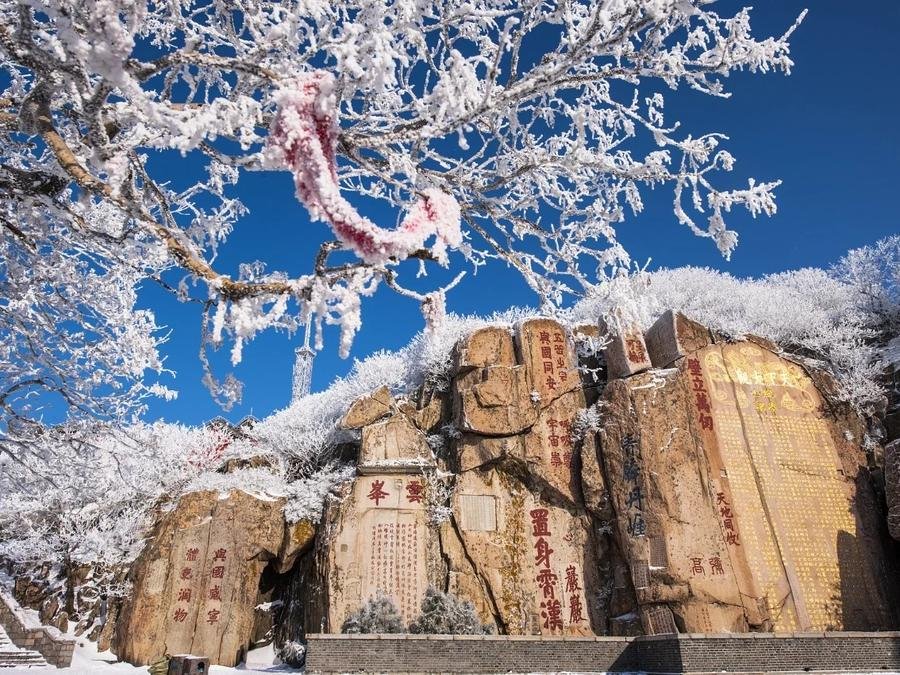
The Mystic Area of Mount Tai, known as the Central Route Scenic Area, is the most renowned hiking route. This path stretches from the starting point at the First Heaven Gate to the Middle Heaven Gate and finally to the South Heaven Gate, covering a distance of 5.5 kilometers. The route is characterized by its winding mountain path, comprising a total of 6,290 stone steps. Key attractions along this route include the Dai Temple Archway, Guandi Temple, First Heaven Gate, Confucius Climbing Site, Hongmen Palace, Wanshen Tower, Doumu Palace, Sutra Stone Valley, Hutian Pavilion, Middle Heaven Gate, Yunbu Bridge, Five Pines Pavilion, Looking-at-the-People Pine, Twin Pines Mountain, Taishan Dream Fairy Grotto, Immortal Ascension Archway, and the Eighteen Bends. This area offers a rich combination of historical and cultural sites, blending natural beauty with spiritual significance, making it a must-visit for hikers and pilgrims alike.
Vast Area of Mount Tai (泰山旷区)
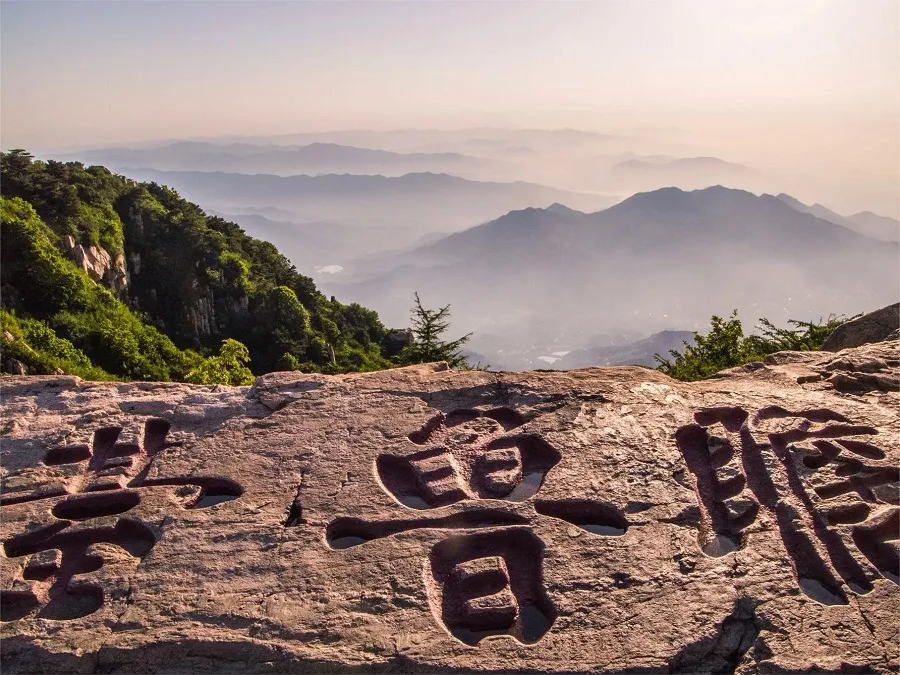
The Vast Area of Mount Tai, also known as the Xixi Scenic Area, encompasses the western route for climbing the mountain. Starting from the Dazhong Bridge, there is a winding mountain road that leads directly to the Middle Heaven Gate. Additionally, there is a separate hiking path for those who prefer to walk. Major attractions in this area include the Huangxi River, Longevity Bridge, Wujimiao Temple, Yuanshi Tianzun Temple, Shanzi Cliff, Tiansheng Fort, Black Dragon Pool, and White Dragon Pool. This area is noted for its expansive natural landscapes, serene environment, and historical temples, offering a tranquil and less crowded alternative for visitors to explore the majesty of Mount Tai.
Wonder Area of Mount Tai (泰山妙区)

Ascending through the Mystic Area and past the Eighteen Bends, climbers reach the South Heaven Gate, entering the Wonder Area, which is the Summit Scenic Area of Mount Tai. This area boasts some of the most breathtaking and culturally significant sites on the mountain. Key attractions include the South Heaven Gate, Moon Watching Peak, Heavenly Street, White Cloud Cave, Confucius Temple, Bixia Temple, Tang Dynasty Cliff Inscriptions, Jade Emperor Peak, Sea Exploring Stone, Sunrise Viewing Peak, and Zhanlu Terrace. The Wonder Area is renowned for its panoramic views, historical temples, and sacred sites, offering visitors a combination of natural splendor and deep cultural resonance. From watching the sunrise at the Sunrise Viewing Peak to exploring the ancient inscriptions and temples, this area encapsulates the essence of Mount Tai’s historical and spiritual heritage.
Mysterious Area of Mount Tai (泰山奥区)

The Mysterious Area, centered around Houshiwu (Back Stone Site), can be accessed via a cable car from the Summit Scenic Area (Wonder Area) of Mount Tai. This area is known for its tranquil and secluded atmosphere, featuring numerous fascinating attractions. Key sites include Eight Immortals Cave, Granny Temple, Duzhupan (One-Legged Climb), Tianzhu Peak, Jiulong Ridge, Huanghua Cave, Lotus Cave, and Yao Viewing Terrace. Additionally, the area is home to various unique pine trees such as Yuanyang Pine, Wolong Pine, Feilong Pine, Sister Pines, and Candle Flame Pine. This area is ideal for visitors seeking a more serene and less frequented part of Mount Tai, offering a blend of natural beauty and mystical charm.
Graceful Area of Mount Tai (泰山丽区)

The Graceful Area comprises the foothills of Mount Tai and the urban scenic area of Tai’an City. Major attractions in this area include Shuanglong Pool, Yaocan Pavilion, Dai Temple, Daizong Archway, Queen Mother Pool, Guandi Temple, Puzhao Temple, Five Sages Shrine, Hanming Hall, Sanyang Temple, and other continually developing new attractions. This area offers a combination of natural and cultural sights, making it a comprehensive introduction to the historical and spiritual significance of Mount Tai. It is particularly noted for its accessibility and the ease with which visitors can explore both the natural and man-made wonders of the mountain and its surroundings.
Beautiful Area of Mount Tai (泰山秀区)

The Beautiful Area includes the Peach Blossom Valley and Cherry Park Scenic Areas, located on the western slopes of Mount Tai. A cable car provides direct access to the main peak from here. Cherry Park is conveniently located near the city, making it a popular spot for Tai’an residents to relax and enjoy their holidays. The Peach Blossom Valley Scenic Area boasts several noteworthy attractions such as Sanchajian (Three Forked Stream), Menghu Valley, Colorful Stream, Rear Zhaimen, Wu Daoren’s Hermitage, and Valley Entrance. This area is celebrated for its picturesque landscapes, offering a charming and relaxing environment for visitors to immerse themselves in nature’s beauty. It is an ideal spot for those looking to enjoy leisurely hikes, scenic views, and the tranquil ambiance of the western part of Mount Tai.
Lengends about Mount Tai
Dongyue Dadi (东岳大帝)
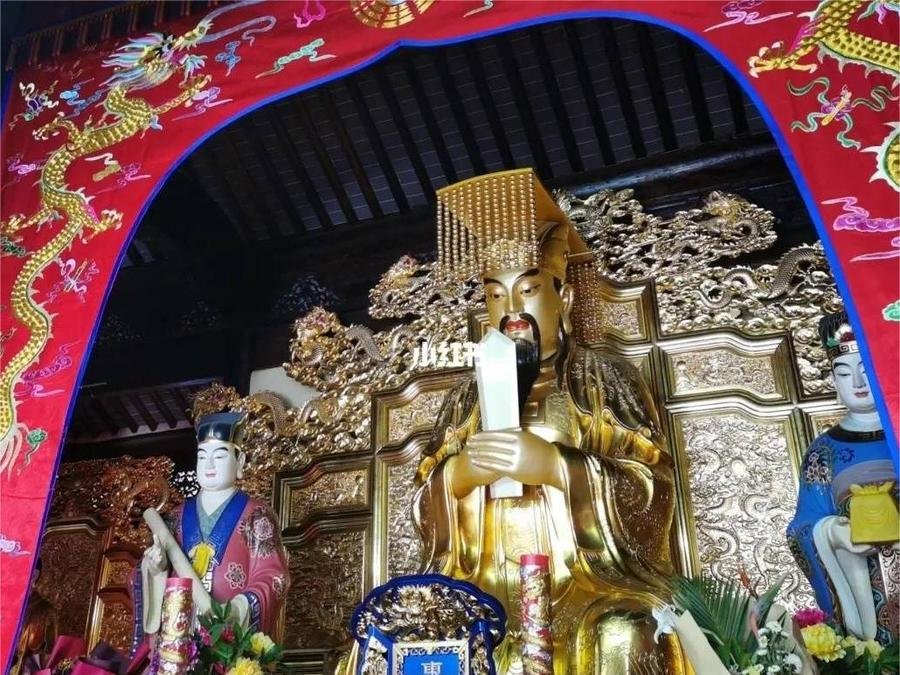
Dongyue Dadi, also known as the Great Emperor of the Eastern Peak, is a revered deity in Taoism deeply rooted in local folk beliefs surrounding Mount Tai. The mountain itself was traditionally worshipped as the Eastern Peak, believed to be the residence of divine spirits and souls after death. Dongyue Dadi became personified over time, assigned with surnames, personal names, and even considered to have spouses and children in popular imagination.
During the Western Han Dynasty, beliefs in the governance of souls by Mount Tai’s deity were recorded in ancient texts and epitaphs. The “Zhenmu Quan” unearthed from Eastern Han Dynasty tombs includes phrases such as “The living belong to Chang’an, the dead belong to Mount Tai; separated in life and death, there shall be no interference,” highlighting the profound cultural and religious significance of Mount Tai as a place of spiritual transition and governance.
Taishan Nainai (泰山奶奶)
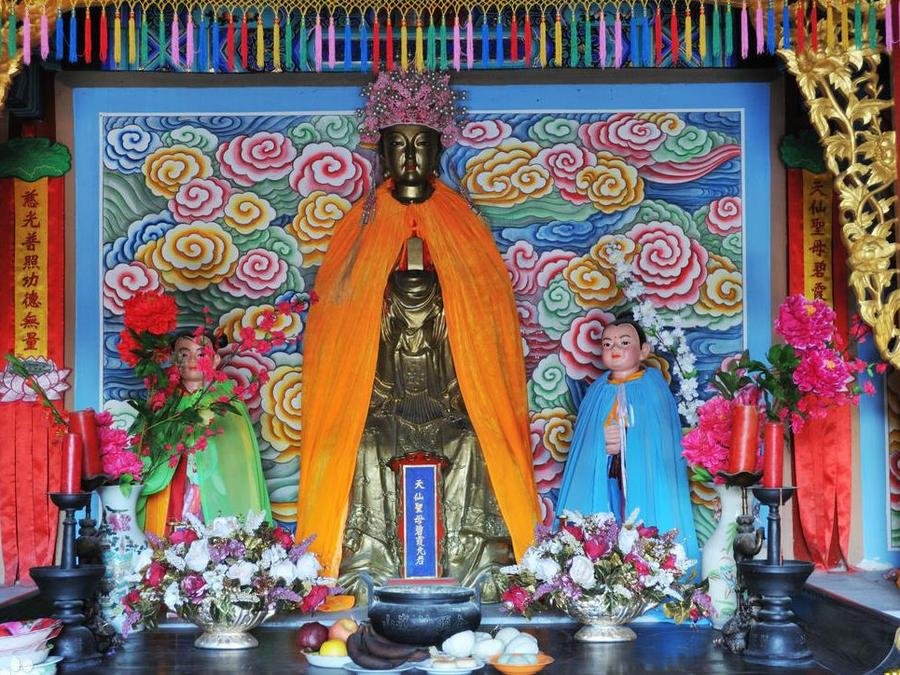
Taishan Nainai, or Granny of Mount Tai, is another significant figure in the mountain’s folklore. According to legend, she was born as Yuye, daughter of Shi Shoudao and his wife Jin, from Sunning Prefecture in Xiniu Country. She displayed exceptional intelligence and spiritual awareness from a young age, eventually embarking on a path of Taoist cultivation in Huanghua Cave on Mount Tai. After three years of practice, she attained immortality and became known as the Jade Maiden of Mount Tai, revered for her benevolent protection over the people.
In Taoism, Taishan Nainai is believed to command celestial troops and oversee matters of good and evil, life and death, under the command of the Jade Emperor. She is venerated for her ability to heal the sick, protect travelers, bless marriages, and ensure prosperity in agriculture and commerce. Statues and images of Taishan Nainai often depict her holding a child, symbolizing her role in ensuring the health and well-being of women and children, and facilitating fertility.
Taishan Shigandang (泰山石敢当)
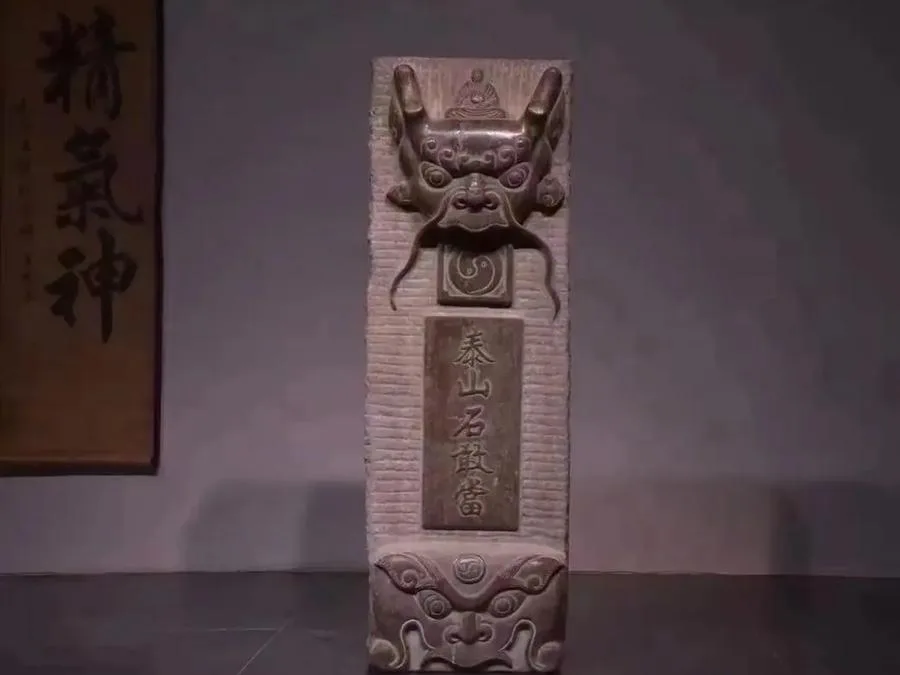
Taishan Shigandang refers to stone tablets inscribed with the characters “泰山石敢当” (Taishan Shigandang), which are believed to possess protective powers against evil spirits and misfortune. These stone tablets, about one meter tall, were historically placed at strategic locations such as bridges and gateways, or embedded into the walls of houses, to ward off malevolent forces and ensure blessings upon the inhabitants. This practice remains popular in folk traditions and was recognized as a national intangible cultural heritage in 2006 for its cultural significance and enduring folk belief.
Vlog about Mount Tai
Climate in Mount Tai
Mount Tai Scenic Area features a warm temperate humid monsoon climate with distinct seasonal changes. Spring is characterized by dry weather and strong winds, while summer brings high temperatures and abundant rainfall. Autumn offers clear skies and refreshing weather, while winter is cold with little snowfall. The average annual temperature is around 13°C.
The climate exhibits significant vertical variation. In January, the average temperature at the foot of the mountain is -3°C, while at the summit it drops to around -9°C. In July, the average temperature at the foot is 26°C, whereas at the summit it averages around 18°C. Annual precipitation increases with altitude, with the summit receiving approximately 1132 mm of rainfall annually compared to 722.6 mm at the base.
The area experiences distinct seasons at lower elevations, resembling a typical temperate climate, while higher elevations enjoy a spring-like climate for three seasons, except for winter, which is characterized by prolonged cold and icy conditions. The summit experiences frost and ice formations such as frost flowers and rime, with the lowest recorded temperature being -27.5°C.
Overall, the period from April to November is considered the best time to visit Mount Tai, when weather conditions are generally favorable for tourism activities.
History of Mount Tai
Mount Tai, also known as Dai Mountain or Dai Zong, primarily formed during the Neoproterozoic and Paleozoic eras. Throughout its geological history, it experienced multiple tectonic movements and crustal uplifts, leading to its current majestic topography. The continuous deformation, fracturing, and uplifting of the earth’s crust played a significant role in shaping Mount Tai.
Historical records suggest that Mount Tai had already become an important sacrificial site by the late Shang Dynasty. During the Spring and Autumn Period, the mountain became a coveted territory among various states. In 219 BC, during the 28th year of his reign, Qin Shi Huang, the first emperor of China, unified the country and brought Mount Tai under centralized management. Over time, Mount Tai evolved into a significant venue for imperial ceremonies and coronations.
In the Tang Dynasty, Mount Tai emerged as a crucial political, economic, and cultural hub. The renowned poet Du Fu immortalized the mountain in his famous verse, “How is the great Tai Mountain? Its green remains unmatched in Qi and Lu.”
From the Song Dynasty onwards, Mount Tai became a prominent center for both Daoism and Buddhism, establishing its status as a cultural landmark. The Ming and Qing Dynasties further elevated its significance. It became a favored site for imperial visits and civil service examinations, attracting scholars and poets who were inspired by its scenic beauty to compose literary works.
In the modern era, Mount Tai witnessed significant historical events. From 1932 to 1935, General Feng Yuxiang, in protest against the National Government’s policy of non-resistance, chose Mount Tai as his place of retreat. During his stay, he commemorated the martyrs of the 1911 Revolution by constructing the Martyrs’ Shrine and the Memorial Monument for the Revolutionaries of the 1911 Luanzhou Uprising on the mountain. Following the Xinhai Revolution, Mount Tai transitioned into a public tourist destination.



I climbed Mount Tai all night and waited a long time, but today it’s cloudy and I still couldn’t see the perfect sunrise. What a pity!
I was originally very excited to climb Mount Tai this weekend, but as soon as I got off the high-speed train, I received a notice that the mountain was closed. I was so disappointed.
It is really cold at the top of Mount Tai at night; I was too frozen to be in the mood to watch the sunrise. If you must climb, it’s better to go during the day!
The weather is quite cold for a night hike up Mount Tai, so make sure to dress warmly. The supplies on the mountain are not expensive; bottled water costs only two to three yuan, so you can manage even if you don’t bring your own.
Don’t hike Mount Tai in January. The good news is: we got to see the sunrise. It was beautiful — you could take some lovely photos. The bad news is: it was so cold that I couldn’t stabilize myself; the wind was enormous! It was that kind of bone-chilling cold — especially after climbing the last short stretch up from the Eighteen Bends to the South Heaven Gate, where the temperature suddenly dropped. I felt like it was about minus… Read more »
At the moment I reached the summit, I turned around to look down at the steep path I had traveled. Looking up at the sky, I saw a brilliant blue expanse, where the horizon seemed to blend seamlessly with the city in the distance.
I thought it would be difficult to climb, but in reality, it was quite easy to go up with breaks along the way. It didn’t take as long as 4 or 5 hours.
Recently, it’s not a good idea to hike Mount Tai at night. There are a lot of people throughout the entire journey, and you can only move along with the crowd.